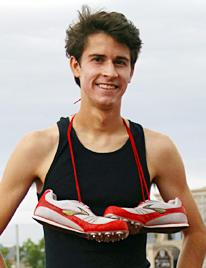Research spurs rising trend of barefoot running in track and marathon runners
By Eric Villanueva ’11
THE ROUNDUP

“They’re weird,” said Will Firth ’11, a Brophy track runner who recently bought a new pair of shoes that have become the newest trend among runners.
Firth unzipped his embroidered Brophy Track and Field bag, dug under his Asics running shoes and gym shorts and pulled out a pair of the newest trend in running shoes.
“It’s like a water shoe, something you wear on the beach, but mixed with a toe sock because each toe has an individual slot,” he added about his new Vibram FiveFingers.
Runners worldwide have set aside high-tech and high-priced trainers for barefoot running – or minimalist footwear like Firth’s Vibram FiveFingers – which research has suggested may be healthier for feet and better for runners.
He put his fingers down the dark green openings for his toes at the front of his new Vibram FiveFingers and held one shoe out like a forest green glove before him.
At first it’s kind of weird with everything between your toes, but you really forget about that when you’re running,” Firth said.
He flipped them over to show a thin rubber sole, which shapes to his foot, with grips for traction that are similar to the cross-hatching patterns of toe prints.
“Every time I run in them I get sore in my feet and my calves because there isn’t a lot of support and my feet have to work harder,” Firth said.
According to a 2009 study by the American Academy of Physical Medicine and Rehabilitation, running shoes increase joint injuries in the hips, knees and ankles.
But for Firth, with his Vibram FiveFingers pain means progress.
“The sorer I get, then the stronger my muscles get and the stronger my feet will be,” he said.
Firth said he first saw the shoes on competitors at track meets. Last month, he bought his Vibram FiveFingers at REI, a sporting goods store, for $80 but has only run in them a couple of times.
So far, Firth said he has not noticed any improvement in his track time due to the shoes.
“I’m hoping to run on my toes a lot more because it forces you up on your toes,” Firth said.
Firth said running on a person’s toes is better than landing flat on the foot because the ball of the foot acts as a springboard for the runner.
“I can see that my calves are getting stronger, which will also help to propel me,” Firth said.
According to Dr. Daniel Lieberman, a professor of human evolutionary biology at Harvard University, in Nature, habitual barefoot runners land on the front of their foot while running, which allows the toes to push off the ground and avoid injury due to heel-striking.
While Firth does not actually run barefoot, Vibram FiveFingers still give him the desired effect, according to Tony Post, president of Vibram USA, in an article on Wired.com.
Post said that Vibram FiveFingers, like bare feet, permit the foot to flex and absorb shock, which causes the toes and arch of the foot to act together like a springboard.
Firth said he is unsure whether or not he will race in his new shoes.
“I have a certain type of racing shoe that I’m really fond, but who knows, I might end up liking these more,” Firth said.
Firth said these shoes are better for cross country races rather than track.
“I can definitely see people wearing them in a Cross Country meet because you’re running in all different terrain,” he said.
Firth said he will wait to see if he ditches the shoes altogether.
“For right now, I can tell that my feet are not calloused enough on the bottom or really rough enough,” he said. “I know that some of the runs I’ve been on my feet would not have survived.”
The one time Firth raced against a runner wearing the shoes, his competitor won, which he said might or might not have been because of his shoes.
Firth said he hopes ultimately the shoes do more than balance the playing field and give him a “leg up.”
For those eager to buy a pair and run, Firth said to work into the shoes little by little.
“I run a lot, and I went out for a three-mile run and it killed me,” he said.
According to Firth, the first couple of runs with the shoe hurt because shoe companies make running shoes cushioned to support a person’s feet and legs.
“The shoe does everything,” he said.
Nonetheless, according to a 2007 paper published in the British Journal of Sports Medicine, 19.4 to 79.3 percent of ordinary runners suffer injuries, predominately in the knees, every year.
Expensive athletic shoes may well exacerbate runners’ knee and other injuries with the promise of “cushioning impact.” High-tech trainers account for 123 percent greater injury frequency than the cheapest sneakers, according to another paper published in the same journal.
According to Dr. Liebermen, added cushioning in running shoes produced since 1972 have conformed runners to taking long heel-striking strides.
When a runner lands on the heel of their foot, the force is comparable to hitting the heel with a hammer with two to three times the runner’s body weight, which the shoe usually absorbs.
Currently, Firth is the only runner on the Brophy track and field team with Vibram FiveFingers, despite his efforts to encourage teammates to test the shoe.
He said people are wary of buying the shoes because they do not understand them.
Nevertheless, the shoe’s popularity is growing one track meet and marathon at a time.
Post, president of Vibram USA, said in The New York Times that sales of the FiveFingers have tripled every year since their introduction in 2006.


















